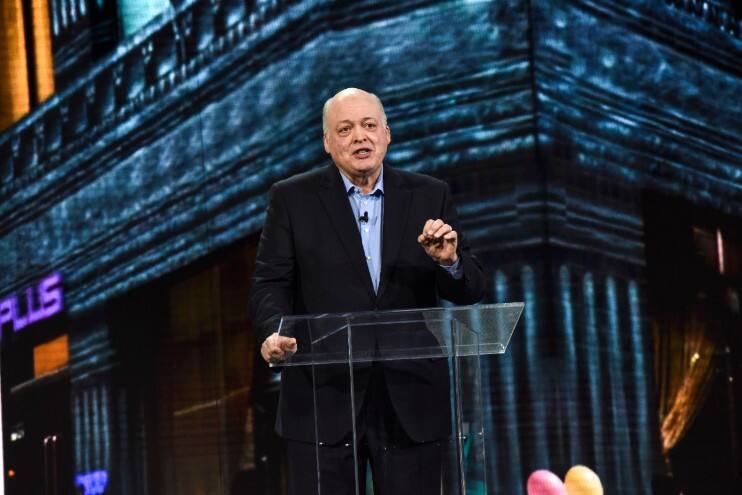 Ford CEO Jim Hackett may have created some breathing room for his tenure and opened a vista into his broader strategy with recent major moves and an upbeat quarterly earnings report from the company.
Ford CEO Jim Hackett may have created some breathing room for his tenure and opened a vista into his broader strategy with recent major moves and an upbeat quarterly earnings report from the company.
The net effect: Hackett’s attack on Ford’s “financial fitness” is beginning to show results, and so is his apparent plan to make it easier for the company to afford the stiff costs of new technology investments in part by creating significant alliances with partners including Volkswagen Group and electric-truck startup Rivian.
Just two years into his time at Ford’s helm, Hackett has far to go to gain the complete trust and confidence of investors, dealers and even Ford employees that he has a cohesive strategy at this point and is following it effectively. Hackett appears to have the support of Ford Executive Chairman William C. Ford Jr., the scion who hand-picked him for the job in spring of 2017, but the CEO’s penchant for remaining opaque about his road map for the future has hurt him.
Just today, for example, it was revealed that Ford workers are less and less likely to understand Hackett’s direction. About 47 percent of Ford employees polled in recent months said they felt top management “gives employees a clear picture of the direction in which the company is headed,” down from 57 percent last year and 81 percent in 2016, according to a Wall Street Journal story. And only 56 percent of respondents this year said they felt “the company was making the changes necessary to effectively compete,” according to the newspaper, about even with last year’s survey results but a decline from 76 percent in 2016, the year before Hackett took over.
Still, the picture for Ford is both brighter and clearer now than even a week ago. Its first-quarter operating profit rose by 12 percent as Ford garnered big margin gains from sales of its pickup trucks and SUVs in the United States and even shored up international losses, including in China, which has been a big trouble spot for the company. Ford CFO Bob Shanks told analysts that he’s “more confident” Ford’s results this year will improve over 2018.
And in the meantime, Hackett has spelled out implicitly that one of his main tactics for helping Ford succeed in the oncoming era of electric and autonomous driving will be to get outside assistance. More automakers worldwide are hooking up with one another and with Silicon Valley tech companies to address the issue.
Ford already has placed one bet, on a budding alliance with Volkswagen – initially for manufacture of some light-truck models in Europe, but presumably with the potential for much broader cooperation.
And last week, Ford revealed that it has invested $500 million in Rivian, a bold startup in suburban Detroit whose founder, R.J. Scaringe, decided to try to create substantial battery-powered pickup trucks and SUVs when everyone else was focusing on electric sedans. Amazon rewarded his vision by leading a group to invest $700 million in Rivian, and after Scaringe flirted for a while with General Motors for its own investment, instead last week he turned to Ford.
Another thing looming on the plus side for Hackett and Ford: an upcoming string of new and overhauled vehicles. It’s still true in the auto business that nothing moves the needle like new sheet metal, and Ford has that coming in abundance over the next year and beyond: a new Ford Ranger mid-size pickup, a new version of its iconic Bronco SUV nameplate, a new version of Ford Explorer and Escape utility vehicles, and new Lincoln models to boot.
Read more: Bill Ford Keeps Hand On Helm Of Ford Motor Through Its Trials

Chief Executive Group exists to improve the performance of U.S. CEOs, senior executives and public-company directors, helping you grow your companies, build your communities and strengthen society. Learn more at chiefexecutivegroup.com.
0

1:00 - 5:00 pm
Over 70% of Executives Surveyed Agree: Many Strategic Planning Efforts Lack Systematic Approach Tips for Enhancing Your Strategic Planning Process
Executives expressed frustration with their current strategic planning process. Issues include:
Steve Rutan and Denise Harrison have put together an afternoon workshop that will provide the tools you need to address these concerns. They have worked with hundreds of executives to develop a systematic approach that will enable your team to make better decisions during strategic planning. Steve and Denise will walk you through exercises for prioritizing your lists and steps that will reset and reinvigorate your process. This will be a hands-on workshop that will enable you to think about your business as you use the tools that are being presented. If you are ready for a Strategic Planning tune-up, select this workshop in your registration form. The additional fee of $695 will be added to your total.

2:00 - 5:00 pm
Female leaders face the same issues all leaders do, but they often face additional challenges too. In this peer session, we will facilitate a discussion of best practices and how to overcome common barriers to help women leaders be more effective within and outside their organizations.
Limited space available.

10:30 - 5:00 pm
General’s Retreat at Hermitage Golf Course
Sponsored by UBS
General’s Retreat, built in 1986 with architect Gary Roger Baird, has been voted the “Best Golf Course in Nashville” and is a “must play” when visiting the Nashville, Tennessee area. With the beautiful setting along the Cumberland River, golfers of all capabilities will thoroughly enjoy the golf, scenery and hospitality.
The golf outing fee includes transportation to and from the hotel, greens/cart fees, use of practice facilities, and boxed lunch. The bus will leave the hotel at 10:30 am for a noon shotgun start and return to the hotel after the cocktail reception following the completion of the round.